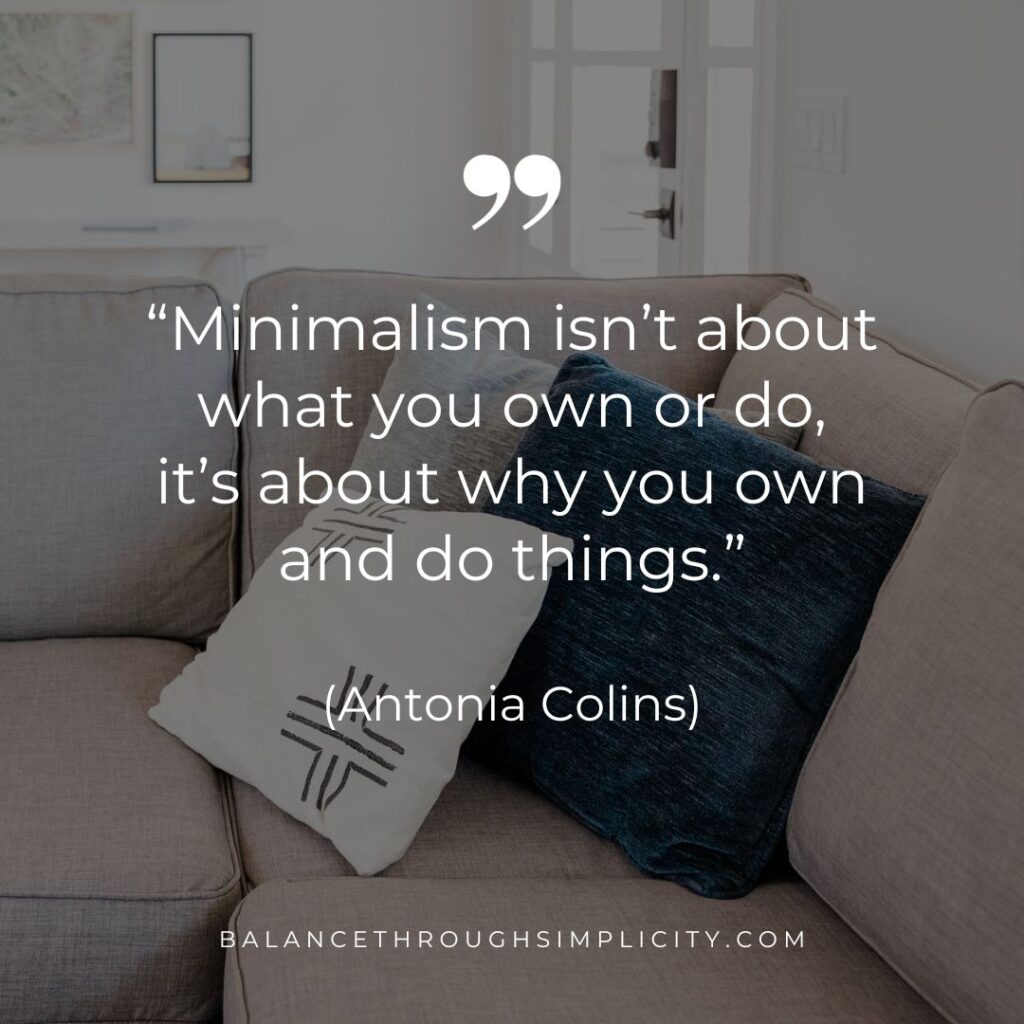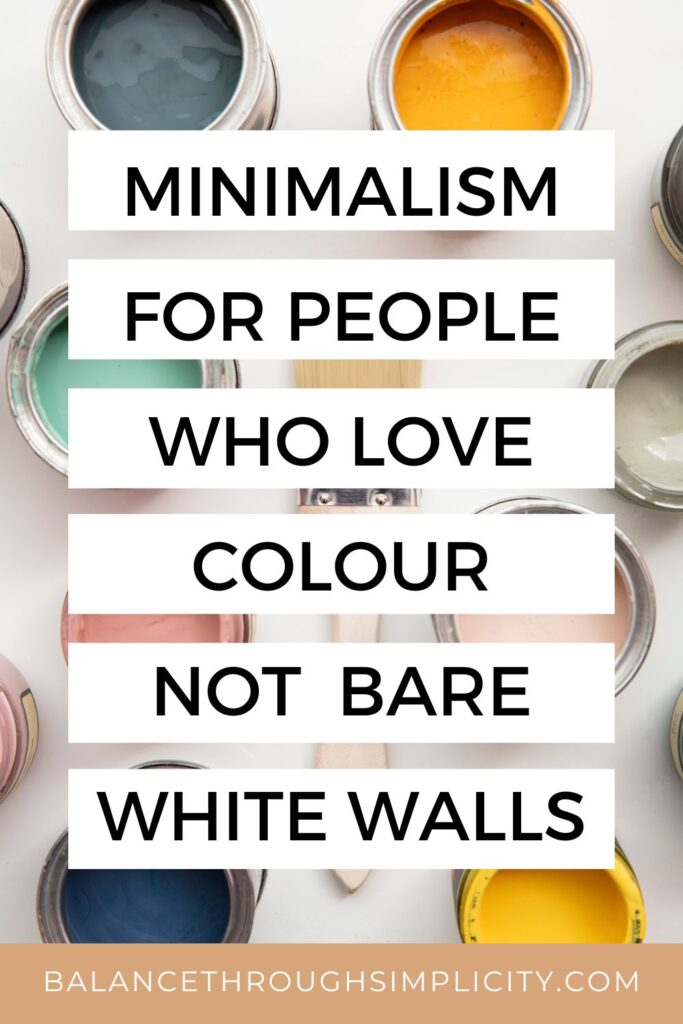MINIMALISM FOR PEOPLE WHO LOVE COLOUR INSTEAD OF BARE WHITE WALLS
Minimalist homes are often associated with monochrome colours and simple, straight lines. In this article I’m exploring how minimalism is really about intentionality, not just a design style. Here are some tips on embracing minimalism for people who love colour instead of bare white walls.
MINIMALISM IS ABOUT WHY YOU DO WHAT YOU DO, NOT WHAT
I was searching for photos to go with an article I’d written recently and wanted a photo of a minimalist family home that still looked like people actually wanted to live there. Unfortunately, most of the photos I came across had bare white walls, little furniture and next to no décor or home accessories. No wonder that many people still find the label of minimalism off-putting!
More than that, when I looked around my own home, even as a minimalist I can see plenty of colour. I can see plenty of neutrals too, but I have bold pops of colour strategically placed to make my brain happy and give interest. Although I love the calmness of more muted tones, I love the expression and emotion that comes with colour including the odd candle, my daughter’s artwork on my walls, my tea towels in the kitchen.
If you’re curious to explore the benefits of minimalism for yourself but feel put off by the bare white walls and sterile, neutral colour palette, in this article I’m sharing some thoughts around minimalism for people who love colour instead of bare white walls!
It’s also a useful example of how minimalism isn’t about WHAT you own or do, it’s about WHY you own and do things.
MINIMALISM AS A DESIGN STYLE AND A LIFESTYLE
Minimalism is an aesthetic style typically associated with a monochrome colour palette, clean and simple lines and functional design. Minimalism is also a lifestyle that encourages us to choose less over more and intentionality in all areas, not just in what our homes look like but in our life in general.
Although one is a design style and the other is a lifestyle, there are parallels between the two. An emphasis on eliminating anything that distracts and removes from what is necessary and important. No clutter, no stuff for the sake of it and nothing present in our home or life that doesn’t add meaningful value in some way.
MINIMALISM AND INTENTIONALITY
Unfortunately, I think this is where the parallels do minimalism as a lifestyle a disservice. The minimalist lifestyle is not about removing everything and living as functionally and sparsely as possible. It can be if you want it to be, but that’s a story for another day.
What minimalism as a lifestyle is actually about is intentionality and awareness. Minimalists clear their stuff not just for the sake of it but because the stuff they get rid of no longer serves a purpose or adds meaningful value in some way. There’s thought, care, purpose and action behind our decisions on what to keep in and what to let go of.

MINIMALISM IS ABOUT MAKING DECISIONS AND ACCEPTING TRADEOFFS
These decisions are based on what adds value to your life and what just clutters, distracts and removes you from the life you’d like to be living. It’s about weighing up the pros and cons of keeping stuff in your home and stuff in your schedule and every other aspect of your every day. If you keep X it means you’ll have to look after it. If you say yes to Y it means you won’t be able to do Z.
There are tradeoffs to every decision you’ll make. But, those tradeoffs are worth it if you stay true to yourself, to your values and priorities and have clarity on what really matters to you.
MINIMALISM IS ABOUT LIVING A FULLER LIFE – WITH LESS
So, in making these decisions, as a minimalist you’ll ultimately be looking to have less clutter, in all its shapes and forms – not just the visual stuff that you trip over and move around. But, that’s not the end of the story.
The beautiful (and, if you like, colourful) next chapter of minimalism is what you’ll choose to fill your new-found space with. Obviously not stuff, but more time, more freedom, more laughter, joy, peace, calmness, gratitude, happiness, experiences, connection, personal growth, leisure, learning. In fact, anything else that’s ultimately more important to you than a house full of stuff that sucks your energy and a schedule that’s overstuffed and overwhelming.
EMBRACING MINIMALISM IN YOUR OWN LIFE
I hope I’m beginning to paint a picture of how minimalism has benefits for so many of us. Especially these days when we’re encouraged to pursue the biggest, best and most of everything – which comes at a price for our mental health, physical and financial well-being. In treading a different and more simple, intentional life, we’ve much to gain by deliberately choosing less.
But, minimalism isn’t a case of chuck everything out and say you’re a minimalist. It takes time, perseverance, effort and a constant awareness of what we let in and keep out of our homes and life. And, of course, a real clear vision of what we want our home and life to look like and what’s important in that home and life, including colour!
FINDING YOUR VERSION OF MINIMALISM
My life, priorities and responsibilities might be different to yours, so too would be some of the choices, actions and decisions I take to live a meaningful, fulfilling life but we could both still be minimalist. There are different extremes. Think of minimalism a bit like a spectrum and you could place yourself at different positions on that spectrum.
As long as we’re intentionally prioritising the things that matter and making a conscious decision to reduce the things that don’t matter, I’d say we’re both minimalists. We might just have found our own version of minimalism to suit us.

CHOOSING COLOUR OVER BARE WHITE WALLS
And so you might be wondering how all this has got anything to do with choosing colour over bare white walls? Well that’s because what colour you choose to paint your walls has nothing to do with whether it fits any rules of minimalism and more about whether you love colour enough to bring it into your home. It’s about your intention and the purpose colour serves to you.
Colour makes us feel things. Red for excitement and energy, blue for trust and peace, green for nature and freshness, purple for royalty and luxury, yellow for creativity and happiness, orange for confidence and success and so on.
Although minimalist homes tend to have neutral palettes, there’s nothing in the minimalist rule book to say that has to be so (at least, not in the way I think about and teach minimalism!).
Different colours makes us feel different emotions and sometimes we want to change the vibration and energy in our home with colour. Maybe even pattern, texture and choice of materials too.
In a busy, chaotic and difficult world, home should be a place where we can retreat to, feel at peace and ease in and express ourselves in whatever way we want, without judgement. If using colour is how you do that, then go for it. Why would a deep burgundy or bright jade green wall be any less minimalist than a white one? You intentionally chose that colour, for a good reason, and it brings you happiness and joy whenever you look at it.
I guess my key point is that minimalism is about intentionality and WHY we do, keep and let go of certain things, not WHAT we do, keep or let go of.
In this article I’m applying this idea to your choice of décor style, but it could equally apply to your vintage record collection or the clothes in your closet. If these things add true value to your life, keep them in. If not, let them go.
TIPS FOR MINIMALISTS WHO LOVE COLOUR INSTEAD OF BARE WHITE WALLS
I did also want to say that minimalist homes do tend to share one other common theme, and that is that they’re often calming, peaceful and clutter-free. This is mostly due to the fact that clutter causes stress and numerous studies have shown that too much stuff makes us feel distracted, unfocused, anxious and overwhelmed.
Minimalism as a lifestyle is very much a reaction to the excess of modern culture and, as a Highly Sensitive Person and introvert who’s easily overwhelmed by too much sensory stimulation, this is one of the aspects of minimalist homes that really appeals to me. Yes, they may be easy to clean and tidy, but they’re also restful and welcoming spaces.
But I love colour. I love art and I get bored of too much neutral without colour to grab my attention and engage my emotions. So, if you’re like me and want a minimalist home with both colour and bare white walls, here are some tips!

HOW TO USE COLOUR IN A MINIMALIST HOME
Here are some tips on how to use colour in your home, mindfully and intentionally.
1.Create a feature wall
Choose just one wall in a room to paint a different colour or cover with wallpaper.
2. Group artwork
If you like artwork on your wall, group the artwork together on one wall, or part of a wall instead of it being dotted around. Groupings feel more cohesive and create greater impact, especially if you use frames of the same colour and design.
3. Arrange ornaments in odd numbers
The mind seems to prefer things in odd numbers so group photos, ornaments and candles in groups of 3 or 5.
4. Choose your accent colours
Be mindful of the different emotions that colours evoke. Think about how these emotions make you feel in the room you want to use them. Your bedroom, living room and playroom (to give three examples) all perform different functions so how do you want to feel in these rooms? To give your home more flow and cohesiveness, choose an accent colour or two and use this same colour scheme throughout the home, instead of choosing different colours for different rooms.
5. Use accessories to add pops of colour
My living room is mostly grey with a wooden floor and cream rug. On my grey sofa I choose different colours, fabrics and patterns for my sofa cushions. Think about ways you could introduce little pops of colour into your home without going to the extreme of buying a new sofa or redecorating a whole room if you don’t have time, energy or money.
Here are some ways you could add pops of colour throughout the house: towels in the bathrooms, appliances in the kitchen, blankets and throws, candles and photo frames, lampshades, rugs.
6. The 60–30–10 rule
This is a rule that interior designers use to put a colour scheme together easily. Choose a main colour and use it in 60% of the space, a secondary colour which you use for 30% and the remaining 10% as an accent colour.
In my home I have pale grey/off-white walls which account for probably 60% of the space, grey I use for 30% and the remaining 10% is made up of blues and greens. However, I do use this rule very loosely because my hallway has a gallery wall made up of my daughter’s artwork which features bold reds, dusky pinks, sunset oranges and my favourite blues and green in different hues. They’re tied together in a cohesive way because they’re all grouped together and they have white frames of the same design, albeit in different sizes.
7. Add plants
Another really effective way of bringing colour into your home is using plants. Although a typical feature of minimalist homes, plants in our homes have many benefits including reducing stress and purifying the air. Different leaf shapes, textures, patterns and colours all add colour and interest.
8. Regularly swap things around
Another way I bring interest and colour into my home is by swapping things around. Moving plants, artwork, cushions, even lighting and the odd bit of furniture from one room to another can add variety and different colour combinations. I don’t have to go shopping to the stores to buy new things, I can shop my home and just move things around. It still feels fresh and new!
9. White space to make your colours sing
Designers use white space (negative space) between different elements. It helps the eye scan better, improves visibility, helps us focus on the important things and prevents visual clutter. If you love colour in your home, don’t then be afraid to use white because it’s boring or bland. Placing your colourful possessions on a white background will bring the colours to life and helps the eye and mind appreciate and focus on them all the more.
10. Experiment
Lastly, sometimes it just takes a bit of experimentation and trial and error to find the colours that work for you in your home. I chose a blue for one wall in my home but hated it. It was too dark, too cold and too oppressive. It looked lovely on the sample card and in the tester pot, but a whole wall of it was just too much. Sometimes it’s just a question of tweaking the shade, tone or tint to make your favourite colour work for you on a wall.

SHARE YOUR THOUGHTS
If you’re wanting to explore minimalism for yourself but worried you’ll have to forego your love of colour and pattern, I hope this article has helped you understand that you don’t have to sacrifice one for the other. Plenty of minimalist homes have colour, energy and individuality – in whatever way that looks like for their occupants!
I’d love to know if you’re a minimalist with a colourful home. How have you found ways to incorporate your love of colour with your love of simplicity. Or, if you’ve been worried that minimalism isn’t realistic for you with a home full of colour, pattern and texture, maybe my article has encouraged you to find a way to combine the two.
Let me know in the comments below what you think!
DON’T MISS OUT!
I’m Antonia and on this blog I share practical inspiration to simplify your home, time and life. Follow me on Instagram, Facebook and Pinterest! You can also subscribe to Balance Through Simplicity and receive regular simplicity tips straight to your inbox for free. Make sure you never miss an article plus you’ll get a copy of my free Declutter Starter Kit as a welcome gift!


Laura
Sunday 19th of November 2023
Terrific article, Antonia. I find it especially relevant personally because those with neurodivergent brains may find very bright colours (etc.) calming, due to their varying needs and thresholds for environmental stimulation. These are great suggestions for adding colour in ways that still make the home feel harmonious and peaceful. Thank you!
Balance Through Simplicity
Sunday 19th of November 2023
Hi Laura, I'm glad you enjoyed it and found the tips helpful! We all need different things to make us feel 'at home' (in both body and mind). Thank you!